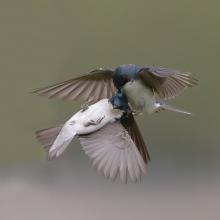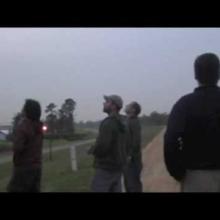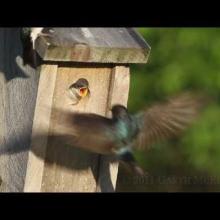

Join BirdNote tomorrow, November 30th!
Illustrator David Sibley and actor H. Jon Benjamin will face off in the bird illustration battle of the century during BirdNote's Year-end Celebration and Auction!
Tree Swallows and bluebirds — like this Western Bluebird — are among the earliest northbound migrants to arrive, heralding spring a month before the equinox. These species will nest only in cavities, such as old woodpecker holes or man-made nestboxes. But the supply of specialized nest sites is limited, and competition is intense. By arriving early, these swallows and bluebirds improve their chances of securing unoccupied cavities. To learn more about building nestboxes, see Related Resources below.
BirdNote®
Nest Cavities — Book Early
Written by Bob Sundstrom
This is BirdNote!
[Rapid series of male Tree Swallow’s song-like notes]
A flash of glittering dark blue cuts through the gray of late February, as a male Tree Swallow glides low over a cattail marsh. The Tree Swallow’s liquid notes hint at spring’s approach. [Repeat rapid series of male Tree Swallow’s song-like notes]
Where a broad, green pasture meets the forest edge, there is a second, even brighter flash of blue. A male bluebird alights on a fence post, the intense blue of its back glints in the welcome sunlight of late winter. [A bit of Eastern Bluebird song]
Tree Swallows and all three North American bluebird species are among the earliest northbound migrants to arrive, heralding spring a month before the equinox. Both species will nest only in cavities, such as old woodpecker holes or man-made nest-boxes. The supply of such specialized nest sites is limited. Competition is intense. By arriving so early, Tree Swallows and bluebirds improve their chances of finding unoccupied cavities – and they may fiercely guard a nest site until April, before actually nesting.
Both species benefit greatly from nest-box programs. But it is crucial to put up only nest-boxes with very specific hole-sizes that encourage these flashy blue migrants but deter non-native starlings and House Sparrows.
To learn about how to provide just the right home for Tree Swallows and bluebirds, come to our website, BirdNote.org.
###
Song of the birds provided by The Macaulay Library of Natural Sounds at the Cornell Lab of Ornithology, Ithaca, New York. Tree Swallow recorded by G.F. Budney. Eastern Bluebird recorded by W.L. Hershberger.
BirdNote’s theme music was composed and played by Nancy Rumbel and John Kessler.
Producer: John Kessler
Executive Producer: Chris Peterson
© 2016 Tune In to Nature.org February 2014/2018/2020/2022 Narrator: Michael Stein
ID#022306cavityKPLU cavity-01b-2010-02-17-MS










